Best Lens for Indoor Sports Photography Nikon
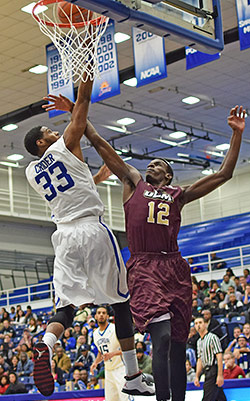
Nikon D3300 w/ 35mm f/ane.8 lens
Shooting indoor sports is tricky, especially on a budget, because you lot accept several critical components working against you in tandem: fast-moving activity & low light.
If you lot remove either of these, then capturing the other becomes a piece of block (with a little practice, at least). But in combination it's a tough nut to crack without a full frame (or at least APS-C) camera trunk and a mighty fast lens (meaning big and bright) and preferably ane with some zoom range.
On a upkeep it becomes even trickier though because budgets more often than not restrict either sensor size or maximum discontinuity of the available lenses, which costs yous dearly in the ability to achieve fast enough shutter speeds. And this is but the get-go of the problem, as you lot also need a camera that can focus reasonably well (rapidly and accurately) in flare-up shooting mode. All of these factors in combination severely limit your potential to get the next paid shooter for Sports Illustrated or ESPN The Magazine while on a upkeep (let's say ~$m - $1500 for a complete rig for the sake of this article, which is less than one-half the cost of an enthusiast sports camera and a good f/2.eight zoom lens).
"Dave, you said this was going to exist a primer, not a downer!"
OK, and so at present to the good news. Photographic camera gear is communicable upwardly, and it's a great fourth dimension to get your indoor sports shooting career going (or at least become neat shots of your kid'south side by side indoor volleyball game or hockey lucifer). And so pull out your pencil and notebook, or better yet, merely bookmark this page for futurity reference, and let's get down to information technology.
In curt, to capture a good indoor activity shot, y'all generally demand to achieve ALL of the following, and I'll discuss means to pull this off on a budget with specific examples I shot recently at a few NCAA basketball games. And considering we're using basketball game equally the focus for this piece, just consider these 5 items below to be your "starting v" players.
Now for the introductions...
Ladies and gentlemen, would you welcome please:
At the point guard position: "Nail Focus"
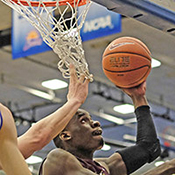
Information technology likely goes without saying, simply an out of focus subject means a picture that isn't worth anything to anyone, as at that place'south little y'all tin do in post-production to relieve an out-of-focus image. Achieving tight, crisp focus is role lensman skill and part camera functionality, and is frequently taken for granted these days because almost cameras tin can do a good job focusing on still subjects in good lighting. But focusing in low calorie-free on fast action is no piece of cake feat, and we'll delve into this a lot more in just a chip.
And starting tonight at shooting guard: "Freeze T. Activity"
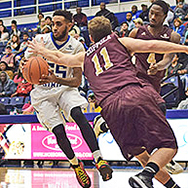
It all depends on the speed your bailiwick is moving, but for most indoor sports similar basketball, volleyball and hockey, the speed of the players and the ball or puck generally demands that you shoot at one/500 at a minimum, but 1/800 and faster is mostly where yous actually start to freeze the motion and avoid the dreaded move blur. But this is where you hit the proverbial roadblock, as speeds like 1/800s and faster generally revenue enhancement budget-priced cameras heavily in low to moderate lighting conditions in the way of too much high ISO racket. But not to fear, nosotros'll explore some good workarounds on a budget for you in a flake.
And at the small forward position: "Noise Own't Cool"
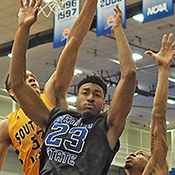
Four-year-olds are noisy, and good photos are not. Unless your sensor and discontinuity are rather large, or yous have a ton of bachelor ambience light, y'all're going to need a higher ISO to allow y'all to achieve a fast shutter speed on a upkeep. But the higher your ISO climbs, and then does the noise, and that's a police (Nikon has learned to bend that law with some of their college-end cameras, simply that'due south a different article.) For this reason, you lot need to larn a camera that can handle ISO 800-1600 (and preferably all the way to IS0 4000 or college) without getting too noisy, and for this you lot'll need to acquire more about sensor sizes and why they're so important for this reason. Nosotros'll delve into this downwardly below.
And upwardly tonight at the power forrad position: "In Your Face"
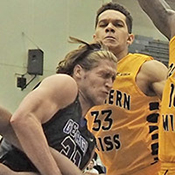
Getting close to the activeness can exist the deviation between a boring shot and a great one, which ways you generally demand some telephoto range and/or some resolution from which to crop a good photo. The telephoto route is usually the better bet for several reasons, coming upward, but this begins to really get tricky on a budget, as the apertures typically starting time to dim on all budget-zoom cameras and lenses. Simply not to worry, as nosotros've got i easy workaround to discuss in a bit.
And give a big manus for the starting center tonight: "Yous!"
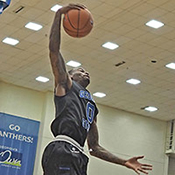
Most team sports have a player called "the centre." For this piece, the center is y'all equally a photographer acquiring the all-time gear you can afford, aiming to position yourself for the best distance and angle, learning to punch in the all-time settings for your rig and having the discipline to wait out the best shots. We'll get over all of this in plenty of particular!
And then these are the basics, and there's a lot more to keep in mind besides. But offset...
Before we go whatever further, delight be advised: At that place are currently no photographic camera rigs on the marketplace costing anywhere close to $1000 or less (new) that can achieve the holy grail combination needed for professional sports photography of a large sensor (low noise as ISO rises), large aperture of at least f/2.eight (fast shutter to freeze action), a good zoom range (to get y'all closer to the action) and stellar continuous autofocus performance (for focusing on moving targets). This combination is the realm of the large rigs, and why people pay the big bucks and build their biceps to exist able to tote them effectually. Your kit lens on your new DSLR is good for general-purpose photography and can produce outstanding images if used correctly, but it's not so useful in the typical indoor sports arena. And the continuous autofocus of about budget DSLRs is good but not stellar in those mid-level price ranges.
In other words, we need to curve the rules in a few means to become ourselves into contention on a budget, and we'll need to learn a few new tricks. This rule-angle and fox adoption may vary depending on the rig y'all choose and your own shooting conditions (light level and proximity to your subjects), but we'll try and lay out as many options here as possible. When you lot pace into your next gym, y'all'll be armed with the right rig on a budget and the all-time tricks upwards your sleeve.
"Dave, await... this is starting to sound like information technology's going to be above my caput!"
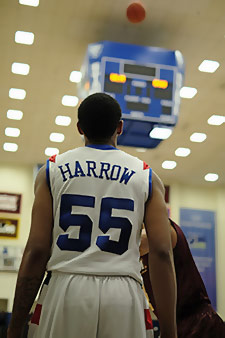
Information technology probably volition be at first if y'all're only starting out, but bear with me. Information technology'southward taken me a long fourth dimension and I'm still learning the ropes and bugging my colleagues for training and tips, merely I'grand hoping this will get y'all there much faster than it took me. Likewise, I don't want any of you dropping out of further reading considering yous start to feel overwhelmed, so I'grand going to make you a deal -- in many of the following sections I'll provide a " bail-out surface area " beneath the details, so if you lot offset sinking at whatever betoken just take a deep breath and then driblet down and read the bail-out department instead, and then proceed to the side by side section.
[And for you adventurous readers out there, I've added a bonus folio afterward this principal piece for anyone looking for "extra credit" and further exploration.]
They say information technology's all-time to start at the beginning, and to this I say...let'south commencement at the end! In other words, take a quick glance frontwards in time to the first corking indoor sports shot you're going to achieve, the ane that makes you excited to share online and gets friends, family, co-workers and colleagues looking amazed and asking how yous got it. A fabulous shot of anything from your favorite pro athlete scoring to your child's beginning hockey goal celebration. Film the shot and the reactions, how much meliorate your shot is than Sally'southward smartphone shot, or even your neighbour Pat'due south DSLR-with-kit-lens shot. Let that feeling sink in, and so we'll explore how you're going to pull it off.
Driving the lane
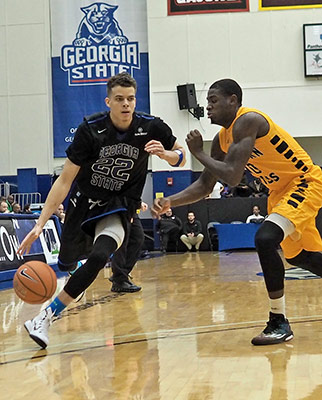
Let'south dive a bit deeper now into the general mechanics of all this. I'll endeavour not to discuss anyone'southward caput, but in that location are a few things that are critical to your success hither. In each category we'll likely be throwing out a deeper concept than you're used to if you're new to all this, merely I'll try and balance it out with uncomplicated ways to remember what to do in the moment. I sometimes spend an 60 minutes prepping in my part for an indoor shoot, only to get out there in the crowd and the noise and get a bit bare on everything I merely studied for the shoot. For this reason, I started bringing along a cheat canvas in the side-pocket of my camera bag... certain settings I'd like to experiment with or various modes. I don't ever employ it, but information technology's there if I need to ground myself, and then I advise you to do the same. And don't forget... if yous start to feel over your head at whatsoever point below, just drop to that expanse's "bail-out expanse" and run across if that makes more sense to you.
Now permit's get to know your starting five players a scrap better.
Nail Focus
Cameras can focus for you lot automatically, or you tin can focus manually. In sports shooting where in that location'south constant motion, information technology's hard to pull off transmission focus unless you pre-focus on one spot and expect until the movement gets in that location, because the players are unremarkably moving faster than you lot can adjust focus on your own. Merely learning the fine art of pre-focusing on a detail spot is actually a good thing to learn to do, especially on a budget. I don't advise doing this technique exclusively, merely for parts of the game or match, particularly if yous experience you're not getting many "keepers" while in autofocus, in that location'southward no reason not to try this.
Simply plow your camera to transmission focus (this is sometimes located on the lens itself and sometimes within the camera), focus on something similar the net of the basketball goal, await until players are coming in for a score (and hopefully an opposing cake) and start firing. This can too exist washed on AF-Southward (single shot focus) by half-pressing to focus and leaving information technology there until you fire. In either case it'southward all-time to exist in "burst" or "sequential" shooting way, where the camera fires the shutter multiple times in rapid succession. This will give you several options to cull from on that item drive to the handbasket, and if your pre-focus was shut to the marking, then a burst should usually result in at to the lowest degree one proficient, sharp image (assuming your shutter speed and ISO setting friction match the limits prepare forth in the sections below).
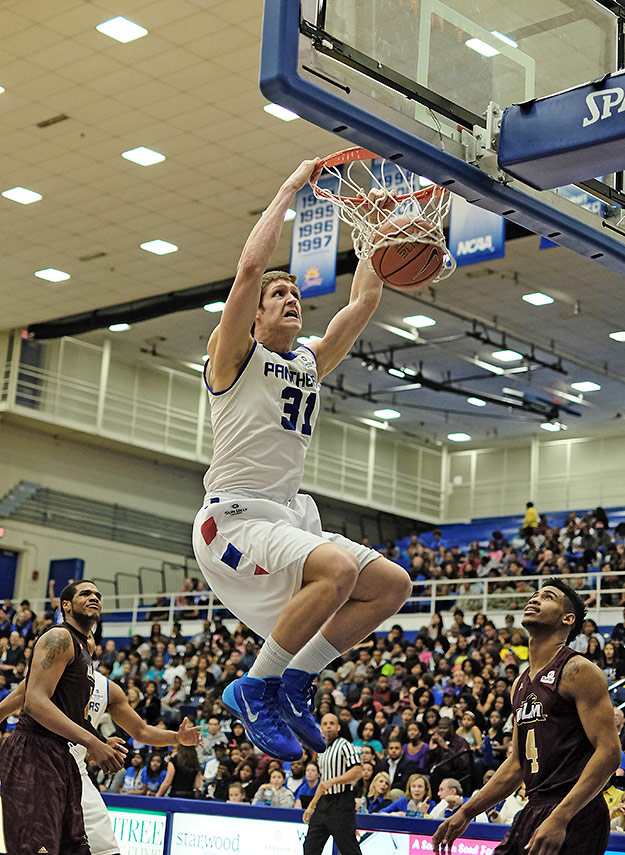
Fujifilm Ten-T1 west/ 35mm (52mm eq.) f/1.four prime lens • 1/800s • f/i.8 • ISO 1600
[original image]
Above is an example using the pre-focus technique in combination with burst mode. I simply pre-focused on the cyberspace (using AF-S) and waited for the activeness to come to it, and in this case it certainly did. The opposing players' reactions are what brand this image more enjoyable than simply a standard dunk, every bit well every bit the raised knees of the dunker, which puts his whole body at or above the oversupply for effect.
But for most of the time yous'll want to allow the camera to lock focus for you. Autofocus settings are becoming more than and more circuitous, and this is a practiced thing for seasoned shooters but oftentimes a confusing one for beginners. The basics are AF-S (single, still shooting) and AF-C (continuous AF). In AF-C the camera will keep to alter focus as subjects motility effectually. This sounds like a natural for indoor sports, simply the speed of the activeness and the relatively low light makes information technology a tough thing to pull off on a budget. To make things more complicated, some cameras cannot continuously autofocus while in burst mode, and some can if you lot switch to a slower burst speed. You'll need to figure this out with your photographic camera'southward pedagogy transmission, as you won't likely want a burst mode that's not irresolute focus for you, unless you're trying out the manual focus technique above and are enlightened that simply part of your sequence might be in focus.
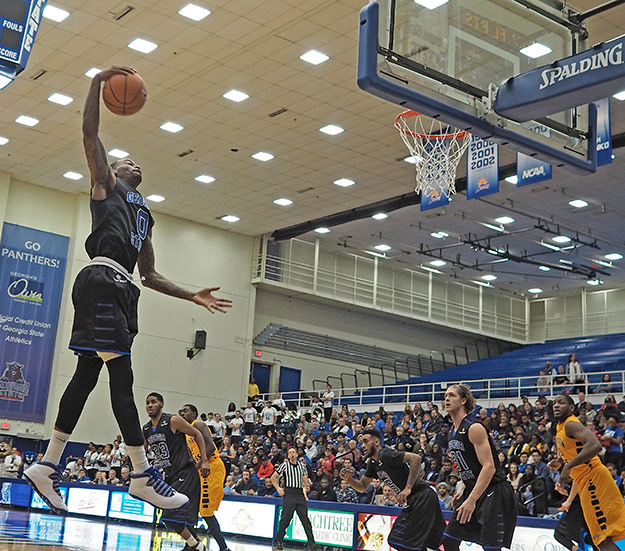
Olympus E-PL7 w/ 17mm (34mm eq.) f/i.8 prime lens • i/500s • f/1.viii • ISO 800
[original image]
For this shot I used AF-S and caught the histrion every bit he was passing in front of me. The wider angle 34mm eq. lens helps add to the overall issue hither, as we're able to scout players, fans and the referee all witnessing the moment. The shutter speed of 1/500s is about the slowest speed I would always desire for indoor basketball, and would have preferred 1/640s even if it meant the ISO jumping to g or 1250. Merely for this particular shot 1/500s freezes most of the action fairly well.
Keeping the camera in AF-S tin can work if you're careful to proceed to re-focus oftentimes (with a half-shutter press), only it'south tough to take hold of motion towards you with any degree of accuracy, because by the time y'all've locked focus the players will have often moved. I notice in AF-C that near cameras in this cost range tend to lose focus frequently, swimming wildly in and out of focus before reacquiring, and sometimes at the expense of missing a practiced moment in the game. Just there'southward really no mode to get around the fact that, on a budget, you will likely need to effort out all three basic AF modes (manual, AF-South and AF-C) to make up one's mind which are best suited for your needs. Hopefully some combination will get you the shots yous're after, because it's not a crime to have ix out-of-focus shots if the 10th shot is crawly and resting proudly on your mantle.

Bail-out area (focus): All camera rigs are unlike, but don't get overwhelmed. All you need to exercise is effigy out yours. Endeavor AF-Due south, AF-C and also manual focus. Practice using each mode, and if you're adventurous you can fifty-fifty attempt specialty modes like "tracking focus" if your camera has it. If all else fails, go to manual focus, pre-focus on a spot where there's ordinarily proficient action on the court or the ice, and wait for the players to get to that spot and burn down like crazy when they become there.
Freeze T. Action and Racket Ain't Cool
These two players are partners and work together most of the time, so it's best to talk about them in tandem. The concept of freezing the action is uncomplicated: athletes are usually in motion, and the best shots are often when they're flight beyond the ice or through the air on the way to the basket. For this reason a fast enough shutter speed is disquisitional, and depending on only how much light there is in your location, you're at present at the mercy of how broad your discontinuity tin go to permit in light, and how much ISO room yous take to exhale before the noise starts to overwhelm. The accented key on a budget and so is making certain you accept a large enough sensor to keep a handle on moderate ISO noise in the center ranges (800-3200) and a lens with a large enough aperture to let in enough of calorie-free (f/2.8 or larger).
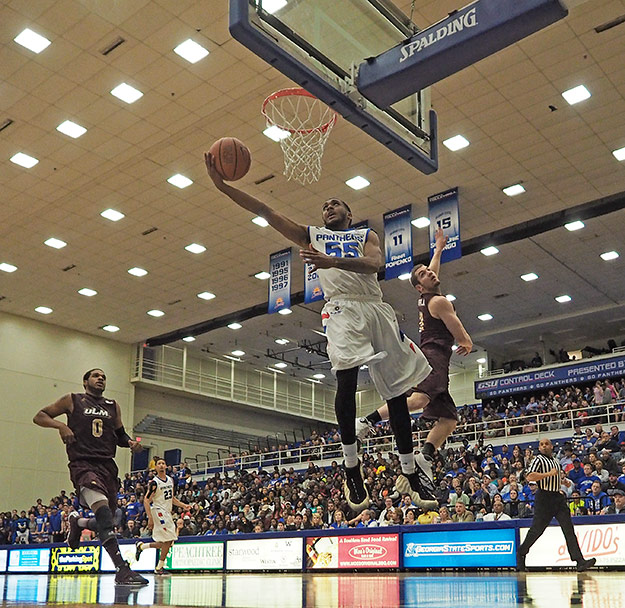
Olympus E-M10 w/ 12mm (24mm eq.) f/2 prime lens • one/1250s • f/ii • ISO 1600
[original epitome]
Shot by my partner William Brawley, who was reviewing the Eastward-M10 at the time, this is one of my favorite indoor sports images. Information technology has bodies flight through the air, other players rushing on and a very nice sense of dynamics. It also has a good combination of shutter speed to ISO, where a typical "sports" mode may have pushed the shutter speed faster and thus the ISO higher, this manual exposure yielded a very overnice blend. At ISO 1600 at that place is merely a trace of racket, and just when y'all zoom in a adept bit, and obviously the 1/1250s shutter speed captured the moment.
I spend most of the game trying to achieve the all-time balance betwixt shutter speed and ISO dissonance. By finding a shutter speed that's fast enough to capture activeness and non going also far above that speed, yous are effectively maximizing your shot'due south potential, because ISO will only climb (in ISO machine fashion) as high every bit it must for the right exposure, and thus not climbing high enough (we hope) to induce noticeable noise. For this reason I tend to stay in shutter priority mode (ordinarily "Southward" on your mode dial) although for some cameras this doesn't work because they may stop the discontinuity downward (seemingly arbitrarily) and thus forcing the ISO to go higher unnecessarily.
If your photographic camera has Program Shift, which ways switching your style punch to "P" and and then using a command dial to shift the shutter speed and discontinuity at the aforementioned time, you tin can endeavor this out. I haven't had much luck because on a budget many cameras either don't allow the shift or don't behave in a logical style when shifting. One camera in this agglomeration (I won't name names hither) wouldn't allow program shift to open the lens all the mode, which I found uber-frustrating at best. And so of course you could go to transmission mode, but sometimes shooting in different directions changes the exposure enough that I don't ever like to stay in transmission manner. Ultimately, you'll demand to experiment with various modes on your ain camera and decide which works all-time in the moment, only shutter priority mode is the best place to first for my tastes.
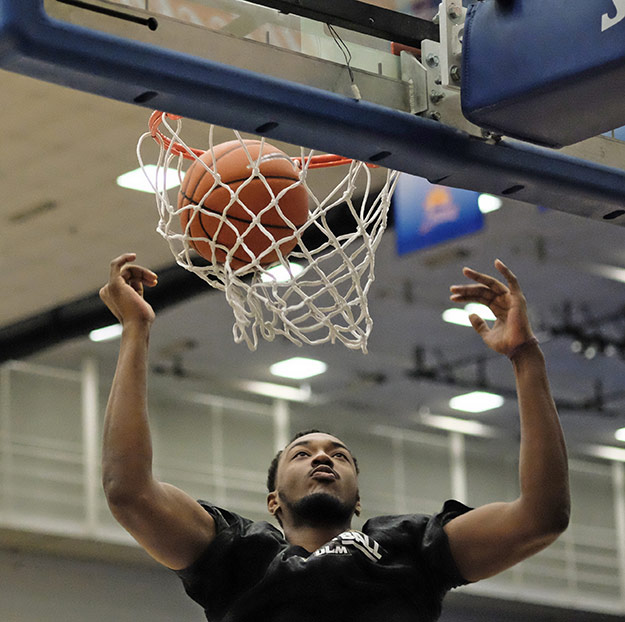
Fujifilm 10-T1 w/ 60mm (90mm eq.) f/2.iv prime lens • 1/1600s • f/two.four • ISO 6400
[original image]
Pushing the limits to ISO 6400 allowed for a super-fast shutter speed of 1/1600 here while cranking the aperture wide open to f/2.4. This is the highest ISO I'd ever recommend on an APS-C camera, and Fuji's tend to practice meliorate than nearly in dealing with higher ISO noise. Below is a one:1 crop of the same paradigm at total resolution to give yous an idea of just how much noise is actually present. In this case, it's a manageable level, merely I don't advise e'er going this high with a 4 Thirds sensor, every bit even some of the APS-C sensors tin't quite handle it likewise as the X-T1 does here.
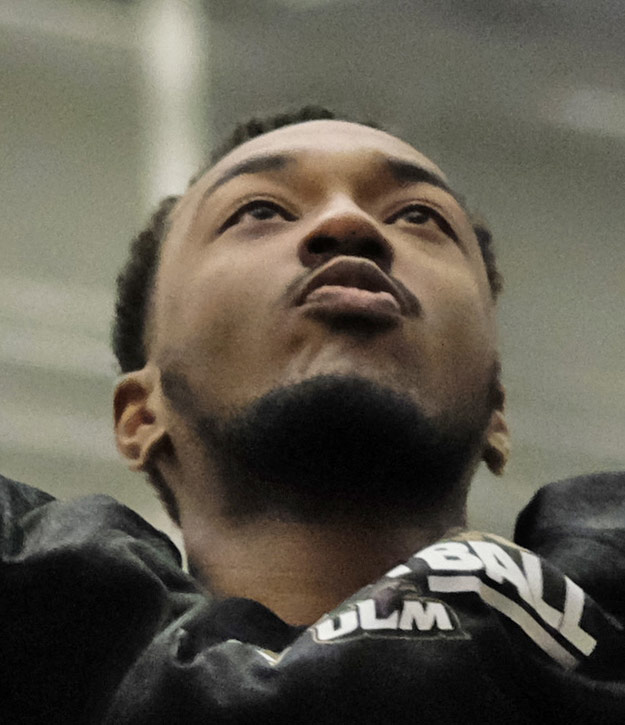
1:1 crop of above image for ISO racket analysis
I observe it critical to limit how loftier ISO goes within the camera, and near cameras today allow you lot to do this, including the five budget choices we shot with here. For Iv Thirds sensors, I generally limit it to ISO 1600, and for APS-C I like to remain beneath ISO 3200, although the ISO 6400 shot above is non bad. This is only my taste for a reasonable noise flooring, and yours may vary depending on your usage and shooting situation. If you really need a higher ISO in society to prevent dreaded motion blur, and so by all means crank it higher! Large prints may start to suffer, simply medium sized prints will concur up for a few stops higher. Small to medium online usage will only show if you crop in, at to the lowest degree until ISO gets a fleck higher.

Bail-out surface area (shutter speed and ISO): If you don't want to be worried about all this particular, and then do the following: Purchase a camera with a sensor that'due south either called "4 Thirds" or "APS-C", and a prime lens with an f/ane.8 or larger aperture (smaller number). Choose the focal length dependent on how close to the activeness you'll be - if you'll be courtside, then 35mm or 50mm eq. is a skillful bet, but if you're farther back in the stands, perhaps 75mm eq. or longer. Continue the aperture at f/one.8 or f/2.0 for indoor sports whenever possible, dial the shutter speed to 1/800s and cheque to come across what ISO you are at. If the ISO is at or below 1600, and so start firing away. If it's at or below 800, go ahead and notch upwards the shutter speed to i/1000s or even i/1250s if your ISO doesn't top 1600. Ultimately you'll need to be the judge of how fast a shutter y'all demand for the sport yous're shooting vs how high your photographic camera can handle ISO noise.
In Your Confront
We've now discussed focal lengths a flake, simply permit's recap a few basics here. I realize that many of y'all want a zoom lens for sports shooting, and this is a natural no-brainer choice. But equally stated earlier, and in that location is no getting around this, you can't have a good indoor sports zoom lens on a budget, considering they don't (notwithstanding) make 1. You lot demand a minimum of f/2.8 as your "maximum" discontinuity for light gathering, but all the better if yous can go to f/ii.0 or f/1.8 (and fifty-fifty f/1.4 on a few budget lenses). We're aiming to keep this budget slice at ~$1500, and a constant f/two.eight zoom lens for Micro Four Thirds or APS-C camera bodies volition put you as well far above the line once yous cistron in the cost of the camera body itself.
And there's some other factor to consider as well, because even if you accept the money for a total frame camera and a huge lens to put on, that rig volition be very large in comparison to the ones used for this piece. This is fine if you're in a special lensman surface area, only it may not delight the people standing around you in the stands. Again, information technology all depends on your situation, only even if money isn't an object it's nice to have a small rig for certain times when a big one isn't practical.
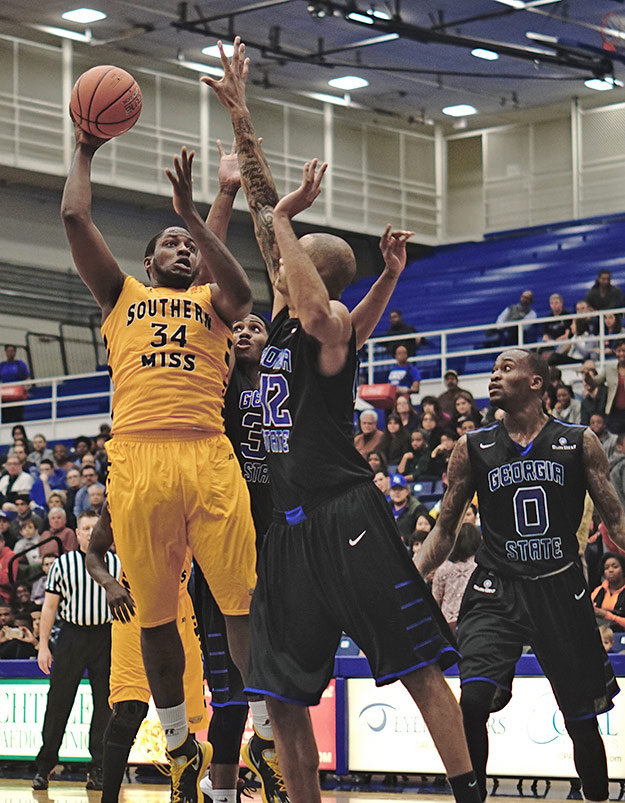
Sony A6000 due west/ 50mm (75mm eq.) f/i.8 prime number lens • 1/640s • f/2 • ISO 800
[original image]
Shot with the pop A6000 combined with a terrific prime lens for the money, the Sony 50mm f/i.8, this image keeps dissonance in check while remaining at ISO 800. The shutter speed of 1/640s also does a proficient job of freezing the activeness, although if the players were moving faster we'd probable want to chance with a college ISO and faster shutter speed. This shot is made more than interesting compositionally by the presense of the ii additional opposing players in combination with the shooter's expression, giving the shot a somewhat menacing appeal.
For all of y'all determined to employ your new kit lens, yous merely tin can't gather enough available light in the boilerplate gym (even this sectionalisation ane NCAA gym we've been shooting in) to be able to freeze the action while adequately limiting your loftier ISO dissonance. It's simple physics, and it'due south simply not possible. On a budget, you demand a fast prime number lens for indoor sports shooting or your shots will be either blurry or noisy or both. So the trick is trying to get one that volition be good for where yous'll be in relation to the players, and if possible, buy more than than 1 so that you have several options.

Bail-out area (choosing the correct lens): Fifty-fifty if y'all don't want to know what "aperture" means or does, you still demand one that can go to f/2.8 or larger (meaning a smaller number similar f/2.0, which simply means a larger physical opening for more than light to laissez passer through). No upkeep kit lens as of this writing tin achieve that, so you lot need to acquire a prime lens with a big aperture, and fortunately for all of us they practise be on a upkeep (see page two for a full rundown of all gear used hither). As far equally which length to choose, take your kit lens to the game where you'll likely be sitting and stone the zoom in and out until yous hit the "sweet spot," and annotation that focal length, so try and buy a fast, prime number lens as close as y'all tin to that focal length. If you lot can afford it, buy more than one at different focal lengths! (Make sure and read the addendum department on page ii for what "equivalent" focal length means before yous do this exercise and make a buy -- very important.)
Yous!
In a higher place all else, be patient with yourself. It's a big deal to make the determination to try and learn how to pull this off well. Bravo for even trying! If y'all get one actually good shot in a two-hour indoor basketball game on a first fourth dimension out you're shooting better than par. Continue experimenting with the settings, especially focus modes and also shutter speeds as it relates to ISO settings. Acquire the rest that works all-time for your rig, location and mode. Try shooting from different angles and distances, and build on what you learn each time.
Additional exploration
We've at present covered much of the basics, also every bit covered some guidelines for the type of gear most likely to go you to home base on a budget. Now let'south talk near some additional specifics that will assistance you tweak and fine-tune your results. For those of you with some experience, by all means proceed on to Page 2 if your encephalon is not nonetheless on overload, but for beginners it'due south OK to take a break at this signal, get and get some existent-world do, and so come dorsum for Folio two when you're ready to dig a little deeper. We'll talk over more topics like metering, composition, mail service-product processing, etc. and will also talk over the rigs we used to capture these images.
Take me to Folio two!
More indoor sports articles:
• Nikon D5500: The best indoor sports camera for under $1000 •
• Indoor sports with a fixed lens camera? Try the Panasonic LX100! •
[A special cheers to my mentors Dave Etchells, Luke Smith, Rob Murray and William Brawley for their guidance and patience with my endless questions. And a big thanks to the Georgia State Athletic Department and basketball programme for allowing us to photograph their games. Lastly, thanks to Nikon, Fuji, Sony and Olympus for the sample equipment used in this piece.]
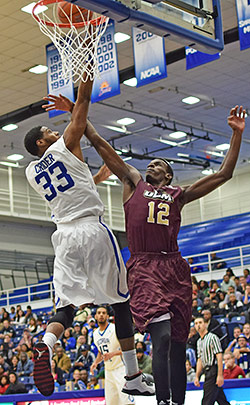
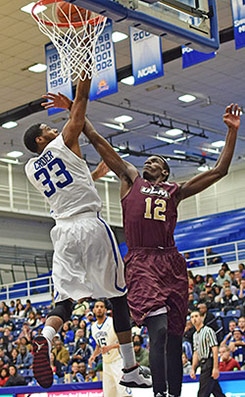

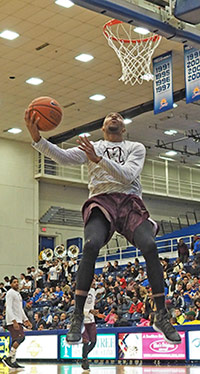
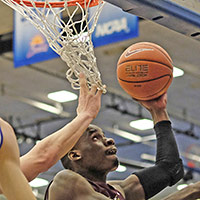
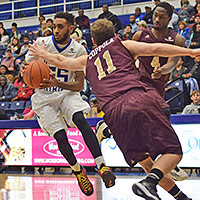
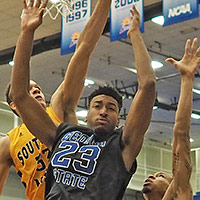
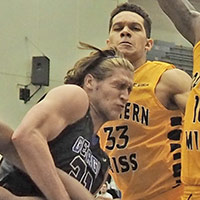
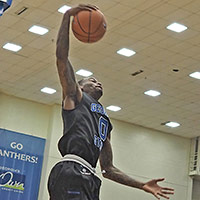
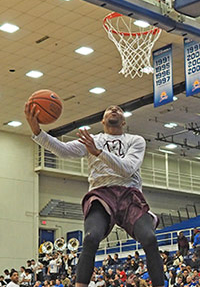
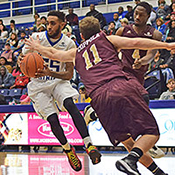
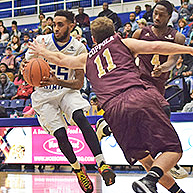

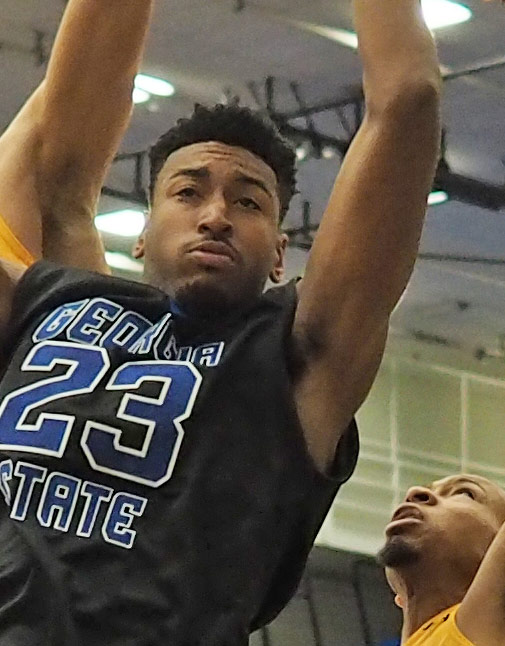
To offer a c
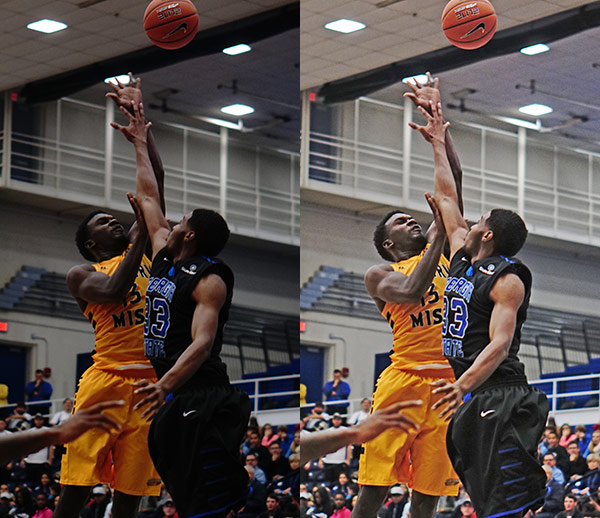
Post-production software, in this example Photoshop CS6, tin can be a friend when your images aren't quite in that location even so. You want to e'er try and get equally close as possible while shooting, as there's only so much you tin can exercise with a bad paradigm, but underexposed images can often be helped back to life.
(The left image is the original while the right has had a number of tweaks later the fact.)
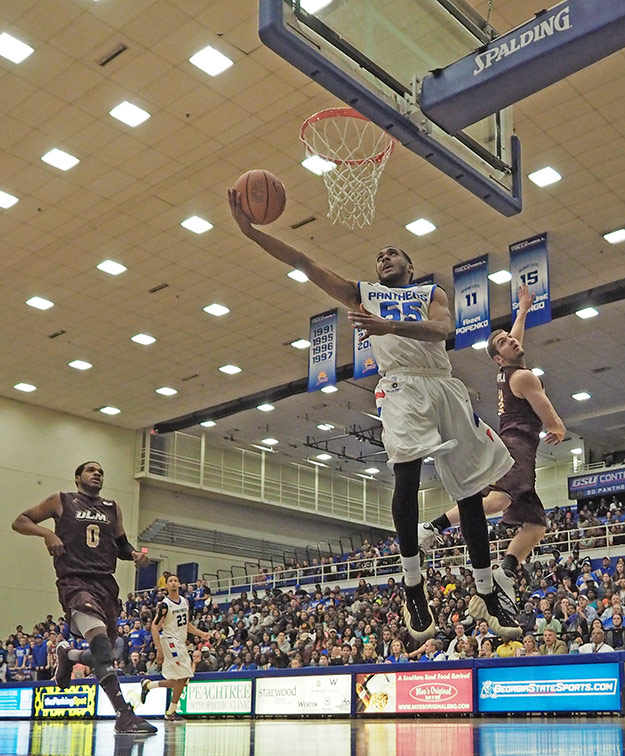
Olympus E-M10 due west/ 12mm (24mm eq.) f/2 prime lens • 1/1250s • f/two • ISO 1600
Shot by my partner William Brawley, who was reviewing the Eastward-M10 at the fourth dimension, this is one of my favorite indoor sports images. It has bodies flying through the air, other players rushing on and a very overnice sense of dynamics. It also has a good combination of shutter speed to ISO, where a typical "sports" way may have pushed the shutter speed faster and thus the ISO college, this manual exposure yielded a actually good blend. At ISO 1600 there is just a trace of noise, and only when you zoom in a expert chip, and plain the 1/1250s shutter speed captured the moment.
0 Response to "Best Lens for Indoor Sports Photography Nikon"
Post a Comment